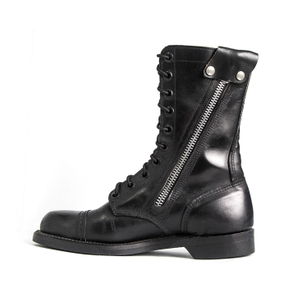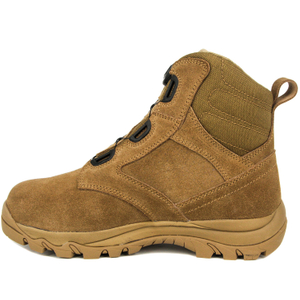Military boots have long been a symbol of strength, resilience, and functionality. Their design, particularly the height, has evolved over centuries to meet the rigorous demands of military operations. The elevated height of these boots serves multiple purposes, from providing enhanced ankle support to ensuring durability in diverse terrains. As we delve deeper into the world of military footwear, it becomes evident that the design choices made are not just for aesthetics but are deeply rooted in the practical needs of soldiers on the ground.
Understanding the military boot market
The global military boot market has seen significant growth in recent years, driven by advancements in technology and a growing emphasis on the comfort and safety of soldiers. In 2020, the market size was valued at USD 2.65 billion. By the end of 2021, it was projected to reach USD 2.67 billion, with a compound annual growth rate (CAGR) of 0.8%. This growth is not just a reflection of increased military spending but also a testament to the evolving needs of armed forces worldwide.
One of the primary drivers of this market growth is the increasing demand for specialized military boots. Modern warfare is no longer confined to traditional battlefields. Today’s soldiers operate in diverse environments, from arid deserts to icy tundras. Each terrain presents its unique challenges, necessitating boots that are not only durable but also tailored to specific conditions. For instance, boots designed for desert operations might prioritize breathability and lightweight materials, while those intended for arctic missions would emphasize insulation and waterproofing.
Technological advancements have also played a pivotal role in shaping the military boot market. Gone are the days when boots were merely leather and rubber. Today’s military footwear incorporates cutting-edge technologies, from moisture-wicking linings to advanced cushioning systems. These innovations not only enhance the comfort of soldiers but also improve their performance and reduce the risk of foot-related injuries.
In terms of market segmentation, the global military boot market is divided into two primary categories: combat boots and tactical boots. Combat boots, as the name suggests, are designed for frontline soldiers. They offer a blend of durability, protection, and functionality. Tactical boots, on the other hand, are more versatile and cater to a broader range of military personnel. They are often used for training, reconnaissance missions, and other non-combat roles.
The Asia Pacific region stands out as the largest market for military boots, accounting for 33% of the global market share. This dominance can be attributed to the presence of emerging economies like China and India, which are significantly increasing their defense budgets. Both countries, recognizing the importance of equipping their armed forces with the best possible gear, have been investing heavily in military footwear, among other defense sectors.
The evolution of military boots
The history of military boots is a testament to the changing needs and strategies of armed forces throughout the ages. In ancient times, the focus was primarily on protection. Soldiers, whether Roman legionnaires or medieval knights, wore boots that shielded their feet from the harsh realities of battle. However, as warfare evolved, so did the design and functionality of military footwear.
By the 19th century, the industrial revolution brought about significant changes in boot manufacturing. The introduction of new materials and production techniques allowed for more specialized designs. The British army, for instance, began adopting ankle-high boots for better support and protection. This era also saw the introduction of the iconic Wellington boot, which, although not specifically designed for the military, influenced military footwear with its water-resistant properties.
The two world wars were pivotal in the evolution of military boots. The trenches of World War I and the varied terrains of World War II necessitated boots that were both durable and comfortable for extended wear. The US army, during World War II, introduced the “Corcoran Jump Boot” for paratroopers, which offered better ankle support and was made of high-quality leather to withstand harsh conditions.
Post-war, the Vietnam War brought about another significant evolution in military footwear. The jungles of Vietnam posed unique challenges, leading to the design of the jungle boot. This boot was lightweight, had a Panama sole for better traction, and was made of materials that dried quickly when wet.
In recent years, the evolution of military boots has been influenced by advancements in technology and a deeper understanding of human biomechanics. Modern military boots are often equipped with moisture-wicking linings, advanced cushioning systems, and materials that offer both durability and comfort. The focus has shifted from merely protecting the feet to ensuring the overall well-being and performance of the soldier.
The design and functionality of military boots
The design of military boots is a culmination of years of research, feedback from soldiers, and advancements in technology. Every aspect, from the height of the boot to the type of laces used, is meticulously crafted to meet the specific needs of military personnel.
One of the most distinguishing features of military boots is their height. Traditionally, military boots were designed to cover the entire ankle, providing maximum protection and support. This design was particularly useful in rugged terrains where the risk of ankle injuries was high. The added height ensured that the ankle was well-supported, reducing the risk of sprains and other injuries. However, this design came with its own set of challenges. The added weight and reduced breathability made these boots less comfortable for extended wear.
In response to feedback from soldiers, manufacturers began experimenting with different heights. The result was a range of boots, from knee-high combat boots to mid-calf tactical boots. Each design offered a balance between protection and comfort. For instance, the knee-high combat boot provided maximum protection but was more suited for specific operations where such protection was paramount. On the other hand, the mid-calf tactical boot offered a blend of comfort and protection, making it suitable for a broader range of military operations.
The materials used in the construction of military boots have also evolved. Traditional leather boots, while durable, were often heavy and not very breathable. Modern military boots, however, incorporate a mix of materials. Nubuck leather, known for its soft texture and durability, is often used in combination with synthetic materials. This blend ensures that the boots are both durable and comfortable. Additionally, the use of waterproof membranes ensures that soldiers can operate in wet conditions without the risk of their feet getting soaked.
The sole of the boot is another critical design aspect. Military boots are often subjected to varied terrains, from rocky mountains to sandy deserts. As a result, the soles are designed to offer maximum traction. Vibram soles, known for their durability and slip resistance, are a popular choice. Some boots also incorporate specific tread patterns to provide better grip on uneven surfaces.
In terms of comfort, modern military boots are equipped with advanced cushioning systems. These systems not only provide comfort but also help in shock absorption, reducing the strain on the soldier’s feet during prolonged wear. Moisture-wicking linings are another essential feature, ensuring that the feet remain dry and comfortable even in humid conditions.
The future of military boots
The future of military boots is a reflection of the changing dynamics of warfare and the evolving needs of soldiers. As technology continues to advance at a rapid pace, military footwear is set to undergo significant transformations, ensuring that soldiers are equipped with the best possible gear.
One of the most anticipated advancements in military boots is the integration of smart technology. Just as smartwatches and fitness trackers have become commonplace, smart boots are set to follow suit. These boots will be equipped with sensors that can monitor various parameters, from the soldier’s foot temperature to the pressure points. Such data can be invaluable in preventing foot-related injuries, ensuring that soldiers remain in peak condition during prolonged missions.
Another area of focus is sustainability. With the increasing emphasis on eco-friendly practices, military boots are also set to undergo a green revolution. Manufacturers are already experimenting with biodegradable materials, ensuring that the boots, once retired, do not contribute to environmental degradation. Additionally, recycled materials are being incorporated into the design, reducing the carbon footprint of production.
Customization is another trend that is set to gain traction in the military boot sector. Just as no two soldiers are the same, neither are their feet. 3D printing technology is already being experimented with in various sectors, and the military is no exception. In the near future, we might see boots that are custom-fitted to individual soldiers, ensuring maximum comfort and functionality.
The design of military boots is a reflection of the evolving needs of soldiers and the changing dynamics of warfare. As we move forward, it is imperative that the design continues to prioritize both comfort and functionality, ensuring that soldiers are always a step ahead.






















